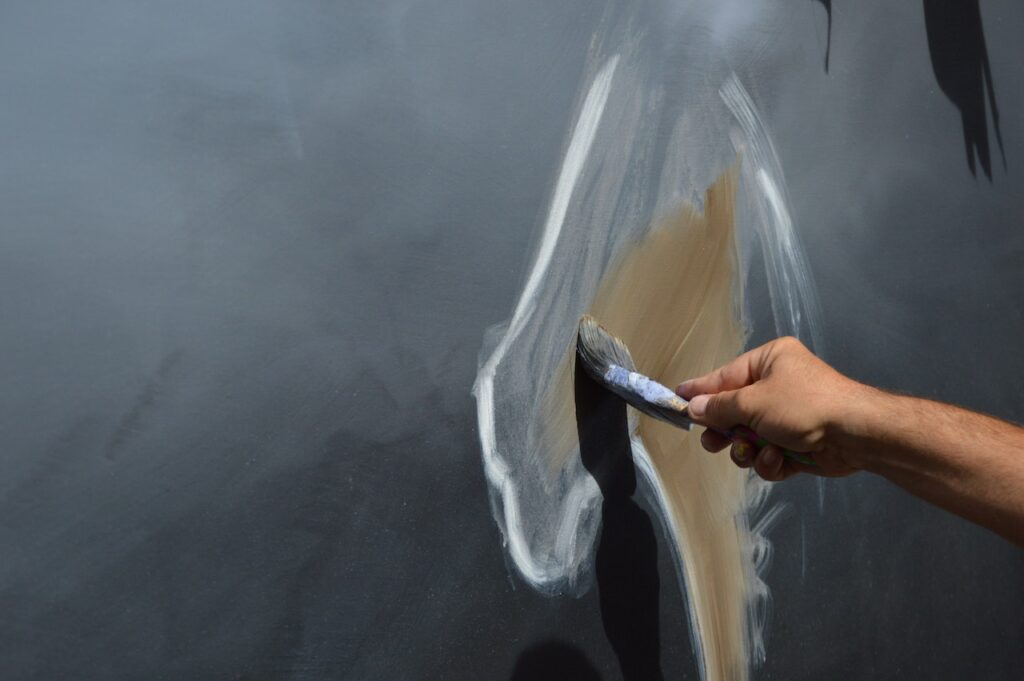Are you tired of amateur results? Look no further! In this guide, we’ll reveal the insider tips and tricks used by professional painters that will make your work stand out from the rest.
From mastering brush techniques to choosing the right tools for each project, we’ve got you covered. Discover how attention to detail can elevate your professionalism and attract more clients. Whether it’s marketing your services or delivering exceptional customer service, we’ll show you how to excel in every aspect of your craft.
So, grab your roller and get ready to unlock the secrets that professional painters swear by. With our expert techniques in hand, you’ll be painting like a pro in no time! Don’t settle for mediocrity – let’s transform your painting game together.
Table of Contents
ToggleBest-Kept Secrets From 8 Professional Painters
Uncover valuable insights shared exclusively by experienced painters. Gain access to hidden gems of knowledge from top-notch painting contractors. Learn the trade secrets that can take your painting projects to the next level.
The Importance Of Hiring Experts
It’s crucial to hire professionals who have the necessary skills and expertise. Experienced painters bring a wealth of knowledge that can make a significant difference in the outcome of your project. They understand the intricacies involved in achieving flawless finishes and long-lasting results.
1. Years of Experience: One of the first secrets shared by professional painters is their extensive experience. Many have spent countless hours perfecting their craft, honing their techniques, and learning from their mistakes. This hands-on experience allows them to tackle any painting challenge with confidence.
2. Attention to Detail: Expert painters pay meticulous attention to detail, ensuring every brushstroke is precise and seamless. They understand that even the smallest imperfections can affect the overall appearance of a painted surface.
3. Proper Preparation: Another secret shared by professional painters is their commitment to thorough preparation before starting any job. They know that proper surface preparation is vital for achieving a smooth and long-lasting finish. This includes cleaning, sanding, patching holes or cracks, and priming surfaces as needed.
4. Quality Materials: Top-notch painting contractors use high-quality materials that are specifically designed for each project’s requirements. From choosing the right type of paint for different surfaces to selecting brushes and rollers suitable for specific applications, they ensure optimal results.
5. Efficient Techniques: Professional painters have mastered efficient techniques that allow them to complete jobs quickly without compromising quality. Their expertise enables them to work efficiently while still delivering exceptional results.
6. Teamwork: Many expert painters work with a crew or employ skilled individuals who complement each other’s strengths on larger projects. This collaborative approach ensures that the job is completed efficiently and to the highest standards.
7. Problem Solving: Experienced painters have encountered a lot of challenges throughout their careers. They have developed problem-solving skills that enable them to overcome obstacles and find creative solutions when unexpected issues arise during a project.
8. Continuous Learning: The best painting contractors understand the importance of staying updated with industry trends, new techniques, and advancements in paint technology. They continuously seek opportunities for professional development to enhance their skills and provide the best possible service to their clients.
By tapping into the expertise of professional painters, you can elevate your painting projects to new heights. Their knowledge, attention to detail, efficient techniques, and commitment to quality will ensure outstanding results that will leave your space looking fresh and vibrant for years to come. So why settle for mediocre when you can benefit from the secrets shared by these experts in the field?
Interior Painting Tips From Experienced Painters
There are expert techniques that professional painters use to achieve flawless results. Whether you’re tackling a small painting job or repainting an entire room, these tips will help you achieve the best possible finish.
Dive Into Expert Advice Specifically Tailored For Interior Painting Projects.
Interior painting requires careful planning and execution. Before starting your project, take the time to prepare the area properly. Clear the room of furniture and cover any remaining items with drop cloths or plastic sheets to protect them from paint splatters. Remove any wall fixtures or switch plates that could obstruct your painting process.
Once you’ve prepared the space, it’s crucial to properly prepare the surfaces you’ll be painting on. Fill in any holes or cracks with spackle and sand down rough areas to ensure a smooth finish. If there is existing paint on the walls, make sure it is clean and free from flaking or peeling before applying new paint.
Learn How Professional Painters Achieve Smooth, Even Coats On Various Surfaces.
To achieve a professional-looking finish, start by using high-quality paint brushes and rollers. Cheap tools can result in streaks and uneven coverage. When applying paint, use long strokes in one direction for a smooth coat without visible brush marks.
When working with different surfaces such as woodwork, ceilings, or walls made of different materials, adjust your technique accordingly. For instance:
- Woodwork: Sand down wooden surfaces before applying primer and paint for better adhesion.
- Ceilings: Use a roller with an extension pole for easy reach and start from one corner of the ceiling while maintaining consistent pressure.
- Walls: Apply primer first to create an even base before adding color coats.
Find Out How To Choose The Right Paint Colors And Finishes For Any Room.
Selecting the perfect paint color can transform a room’s ambiance. Consider these tips when choosing paint colors and finishes:
- Lighting: Take into account the natural and artificial lighting in the room when selecting colors. Test samples on the wall to see how they look under different lighting conditions.
- Room Size: Lighter colors can make small rooms appear larger, while darker shades can add depth to larger spaces.
- Finishes: Different finishes, such as matte, satin, or semi-gloss, offer varying levels of durability and sheen. Matte finishes are ideal for hiding imperfections, while glossy finishes are easier to clean.
Remember to always follow safety guidelines when painting. Use appropriate ventilation and protective gear if you’re working with lead paint or other hazardous materials.
By following these expert techniques and tips from experienced painters, your interior painting project will be a success. With careful preparation, attention to detail, and the right tools, you can achieve professional-looking results that will transform your space. Whether you’re painting walls, ceilings, or furniture, these tips will help you navigate your next interior painting job with confidence.
The Importance Of Proper Surface Preparation
Proper surface preparation is an essential step in achieving a successful paint job. Whether you’re tackling a small DIY project or hiring professional painting contractors, understanding the importance of thorough surface preparation will ensure long-lasting and high-quality results.
Thorough Surface Preparation For Long-Lasting Results
Professional painters know that the key to a durable and visually appealing paint job lies in the preparation of the surfaces. By following expert techniques, they guarantee that the paint adheres well and maintains its finish over time.
One crucial aspect of surface preparation is cleaning. Before applying any paint, it’s important to thoroughly wash and remove dirt, dust, grease, or any other contaminants from the surfaces. This ensures proper adhesion of the paint and prevents any imperfections from showing through.
Sanding is another vital step in preparing surfaces for painting. It helps create a smooth and even texture by eliminating rough patches, bumps, or ridges on walls or other surfaces. Sanding also promotes better adhesion between the paint and the surface.
In addition to cleaning and sanding, using a primer is essential for proper surface preparation. Primers act as a foundation for paint, providing excellent adhesion and enhancing durability. They also help seal porous surfaces, prevent stains from bleeding through, and promote an even finish.
Key Steps: Cleaning, Sanding, And Priming
To achieve optimal results when painting surfaces yourself or working with professionals, it’s crucial to pay attention to every step involved in proper surface preparation:
- Cleaning: Thoroughly clean all surfaces using appropriate cleaning agents to remove dirt, grime, grease marks, or mildew.
- Sanding: Carefully sand all areas that require smoothing out such as rough patches or ridges until they are level with surrounding areas.
- Priming: Apply a suitable primer to prepare the surfaces before applying paint. Make sure to choose a primer that matches the type of surface and paint you’ll be using.
Attention To Detail And Quality Workmanship
Expert painting contractors understand that attention to detail is paramount. They meticulously prepare every surface, ensuring no corners are cut and no imperfections are overlooked.
Professional painters pay special attention to edges, corners, and hard-to-reach areas. By using proper techniques and equipment, they ensure that these critical areas receive the same level of preparation as the rest of the surface.
Furthermore, skilled painters take into account factors such as site conditions, foot traffic, and safety standards. They use appropriate equipment like ladders, scaffolding, or specialized tools to access all areas safely without compromising the quality of their work.
Conclusion: Key Takeaways From Expert Techniques Of Painting Contractors
In conclusion, the expert techniques of painting contractors provide valuable insights and tips for achieving professional-quality results in your painting projects. By following these best-kept secrets and top painting tips, you can enhance your skills and transform your spaces with confidence.
One key takeaway from experienced painters is the significance of proper surface preparation. This step cannot be emphasized enough as it lays the foundation for a flawless finish. Taking the time to clean, sand, and prime surfaces ensures better adhesion of paint and helps to conceal imperfections.
Interior painting tips shared by professional painters highlight the importance of choosing the right tools and materials. From selecting high-quality paints to using appropriate brushes or rollers, investing in good supplies can greatly impact the outcome of your project.
Another crucial aspect revealed by expert painters is their attention to detail. They stress the significance of taking care when cutting in edges, ensuring even coverage, and maintaining consistent brush strokes or roller patterns. These small details contribute to a polished final result that showcases professionalism.
Moreover, learning from seasoned professionals allows you to understand various techniques that can save time and effort. For instance, some painters recommend using specific brush strokes or employing innovative methods like “cutting-in” tape-free for more efficient work.
To further enhance your expertise as a DIY painter or when working with contractors, consider exploring additional resources such as online tutorials or workshops offered by industry experts. Continuous learning will help refine your skills and keep you up-to-date with emerging trends in painting techniques.
In conclusion, mastering expert techniques employed by painting contractors empowers you to achieve exceptional results in your own projects. By implementing these strategies—such as proper surface preparation, attention to detail, using quality tools and materials—you can elevate your painting skills and create beautiful spaces that leave a lasting impression.
Sources:
/home-improvement/painting/how-to-paint-with-a-roller/
Transform Your Space With The Expertise Of A Trusted Painting Contractor!
Ready to give your home a fresh new look? Look no further than PaintMasters, Concord, California’s leading residential and commercial painting company. With over 25 years of experience, we’ve built a solid reputation for excellence in Lamorinda, Tri-Valley, Contra Costa, and beyond.
At PaintMasters, we take pride in our cutting-edge technology and unmatched expertise. Our state-of-the-art 15,000 CFM spray booth ensures a flawless finish for your cabinets. Whether you’re seeking interior or exterior painting, custom homes, deck transformations, acoustic removal, drywall repair, or texturing, our team of skilled professionals has got you covered. With PaintMasters, you can trust that your project will be done right the first time.
But our expertise doesn’t stop at painting. We’re also masters of staining, offering a wide range of options for interior and exterior walls, cabinets, doors, decks, and other woodwork. Whether you’re looking to revitalize a tired room or add a touch of style to a new space, PaintMasters is here to bring your vision to life.
What sets PaintMasters apart is our unwavering commitment to delivering flawless results. Our team combines design instinct with technical skill, ensuring every project is a masterpiece. We take pride in our professional certification and the remarkable transformations we achieve.
Don’t wait any longer to experience the transformative power of a quality paint job. Contact PaintMasters today to schedule a consultation or request an estimate online. Our dedicated team is ready to help you turn your space into a work of art. Get in touch now and let the magic begin!


